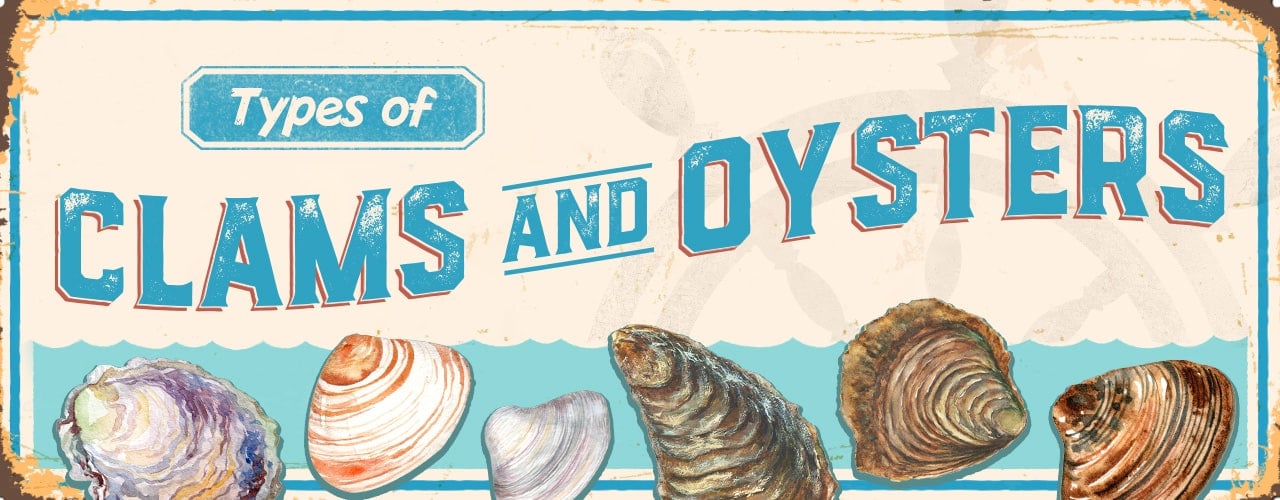
Types of Clams and Oysters
Last updated on 10/26/2023Clams and oysters are popular seafood choices that are considered a delicacy by many seafood enthusiasts. From chowders and pasta dishes to raw bar platters, clams and oysters offer a wide range of possibilities for chefs and restaurateurs. With high praise from the most celebrated cooks, clams and oysters continue to leave their complex flavor profiles on the palates of the most adventurous eaters all around the world. We’ll explore the different types of clams and oysters available, their distinct characteristics, and the various ways you can use them in your kitchen.
Shop All Clams and OystersClams vs Oysters
Clams and oysters are both bivalve mollusks, but they have distinct differences. Clams have a soft body enclosed in a smooth-hinged shell, while oysters have a rough and irregular-shaped shell. In terms of taste, clams tend to have a sweeter and milder flavor, while oysters are known for their briny and rich taste. Clams are commonly used in soups, stews, and pasta dishes, while oysters are often shucked and enjoyed raw on the half shell or used in seafood platters. Both clams and oysters are versatile ingredients that can enhance a variety of culinary creations.
Keep in mind that if you are serving clams or oysters, it is important to add a warning on your menu that consuming raw seafood and shellfish may increase your risk of foodborne illness.
Types of Clams
Clams come in various sizes, scaling from less than an inch to over 4 inches. Different types of clams each have their own flavor profile and distinct texture, which makes them ideal for specific cooking applications.
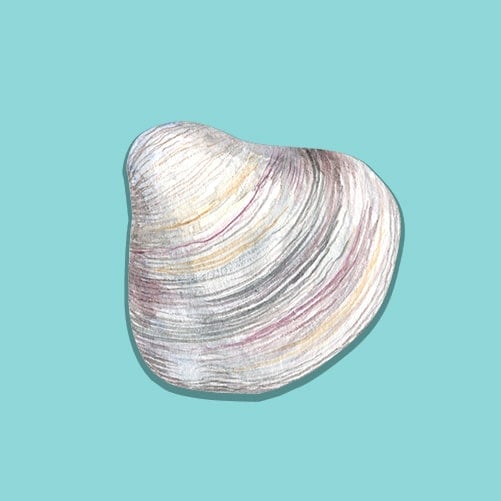
1. Littleneck Clams
Littleneck clams are named after the beautiful Little Neck Bay on Long Island and are the smallest and most tender type of clam. They measure about 1 inch in diameter and are often enjoyed raw on the half shell. They can also be steamed, baked, or used in chowders and pasta dishes. With their delicate flavor and versatile nature, littleneck clams are a favorite among seafood lovers.
- Littleneck Clams Size: 1”
- Littleneck Clams Taste: Mild ocean brininess and pleasantly sweet undertones
- Littleneck Clams Texture: Plump and juicy; the most tender of the clams
- Littleneck Clams Cooking Applications: Most commonly served raw on the half shell or steamed

2. Middleneck Clams
Middleneck clams are known for their medium size and tender meat. They are often used in soups, stews, and pasta dishes, as well as being a popular choice for steaming. Their mild, slightly sweet flavor pairs well with an array of ingredients, making them perfect for seafood menus. Middleneck clams are the minimum size New York State allows to be harvested and sold within its boundaries.
- Middleneck Clams Size: 1 1/4”
- Middleneck Clams Taste: Briny salinity yet small afternotes of subtle sweetness
- Middleneck Clams Texture: Rich, creamy, and firm
- Middleneck Clams Cooking Applications: Steamed over pasta for Spaghetti alle Vongole or in a Spanish seafood paella

3. Topneck Clams
Topneck clams are named after the distinctive shape of their neck, which is thicker and shorter than other types of clams. They are considered the most versatile for cooking applications, since they are tender enough to serve raw on the half shell, and hearty enough to withstand longer cooking applications, such as stewing.
- Topneck Clams Size: 1 1/2” – 2”
- Topneck Clams Taste: Bold, piquant salt overtones interwoven with notes of tangy earthiness
- Topneck Clams Texture: Springy, plump, and firm meat
- Topneck Clam Cooking Applications: Steamed over seaweed amongst other crustaceans in a New England clambake
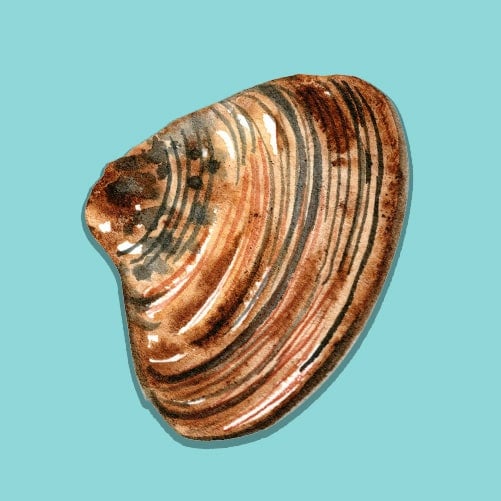
4. Cherrystone Clams
Cherrystone clams are named after the picture-perfect Cherrystone Creek in Virginia, and they are sometimes recognized as a smaller version of Topneck clams. They are larger in size compared to other varieties, making them ideal for steaming, grilling, or baking. Cherrystone clams are often used in clam chowder and other seafood dishes due to their meaty texture. They are also commonly enjoyed raw on the half shell.
- Cherrystone Clams Size: 2” – 3”
- Cherrystone Clams Taste: Lingering salty notes with a smooth, clean finish
- Cherrystone Clams Texture: Pleasantly firm and chewy meat
- Cherrystone Clams Cooking Applications: Stuffed and broiled for the classic Clams Casino or chopped and stewed into a clam chowder
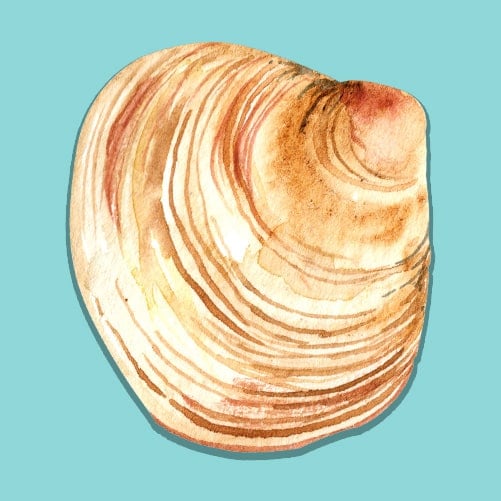
5. Quahogs
Otherwise known as Chowder Clams, Quahogs are the biggest clams and therefore have the toughest meat. These clams are known for their hard shells and are typically found on the Atlantic coast of North America. Quahogs can be prepared by steaming, baking, or frying. Their meat is firm and flavorful, making them a favorite choice for chowders, stuffed clams, and clam-based sauces. Quahogs are also commonly used in clam bakes and seafood boils, adding a delicious taste to these traditional dishes.
- Quahogs Size: 4”+
- Quahogs Taste: Perfectly briny and salty flavor
- Quahogs Texture: Tough and chewy meat that’s ideal for longer cooking applications
- Quahogs Cooking Applications: Creating stuffed quahogs and clam chowder; Not ideal for being served raw or steamed
Back to Top
Types of Oysters
Oysters grow all around the globe on rocks and piers in the saltiest of waters. Their taste and shape depend on where they’re harvested due to their merroir (environmental factors that affect seafood), which is the marine version of terroir. They can range from slightly sweet to bold and briny and are perfect for an array of recipes.
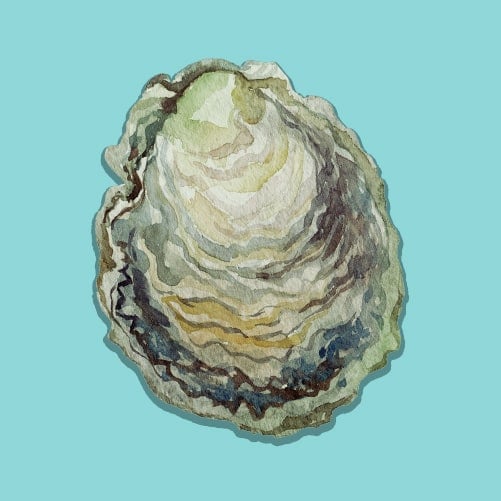
1. Olympia Oysters
Olympia oysters, also known as Ostrea lurida, are a type of oyster that is native to the Pacific Northwest and named after Olympia, Washington. These small oysters are highly prized for their sweet and buttery flavor, making them a popular choice among seafood enthusiasts. Olympia oysters have a distinctive rounded shell and are typically found in estuaries and bays. Because they are so small, Olympia oysters are fragile and therefore protected and cultivated for markets and restaurants.
- Olympia Oysters Taste: Mildly sweet and coppery notes upfront with a crisp finish
- Olympia Oysters Shell Design: Usually the size of a coin, can range from a purple hue to one that’s brown and yellow, and has distinctive ridges creeping up towards the top
- Olympia Oysters Growing Region: America’s Pacific Northwest

2. Kumamoto Oysters
Kumamoto oysters are known for their sweet and buttery flavor. These oysters are native to Japan but are now also grown in the Pacific Northwest region of the United States. They have a small, deep-cupped shell and a delicate texture. Kumamoto oysters are often enjoyed raw on the half shell, but they can also be used in cooked preparations. Their unique flavor profile makes them a favorite among oyster enthusiasts.
- Kumamoto Oysters Taste: Sweet, slightly melon-y, and creamy meat
- Kumamoto Oysters Shell Design: Green and black hue with a bowl-shaped cup and defined, pointy edges
- Kumamoto Oysters Growing Region: Japan, Southern China, and America’s West Coast
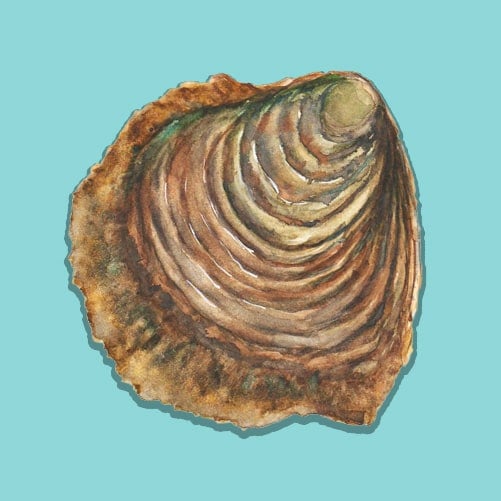
3. European Flats (or Belon Oysters)
European Flat oysters, also known Ostrea edulis, are a popular type of oyster found in European waters. They are often labeled as “Belon Oysters”, but Belon oysters are just a type of European Flat, growing exclusively in the Brittany region of France. These oysters have a distinct flavor profile with a briny, mineral taste, and a buttery texture. European Flats are typically smaller in size compared to other oyster varieties, and their shells are flatter and more irregular in shape. They are highly prized by chefs and oyster enthusiasts for their unique taste and are often enjoyed raw on the half shell.
- European Flat Oysters Taste: Bold, salty brininess with a complementing minerality and slight crunch
- European Flat Oysters Shell Design: Seaweed and gray color with a flat, saucer-like cup
- European Flat Oysters Growing Region: Coastal regions in Europe and Morocco; Authentic Belon oysters are grown exclusively on the coast of Brittany, France

4. Sydney Rock Oysters
Also known as “Auckland Oysters” and “New Zealand Oysters”, Sydney Rock oysters grow in the Oceania region and can have a lifespan of up to 10 years. Although its most recognized namesake comes from Sydney, these oysters do not actually grow in the Sydney Harbor. Sydney Rock Oysters have a distinctive briny taste with a slightly sweet finish and are often enjoyed raw on the half shell or used in seafood dishes.
- Sydney Rock Oysters Taste: Mildly sweet with metallic undertones
- Sydney Rock Oysters Shell Design: Thick and smooth with tight waves along the curve of its shell
- Sydney Rock Oysters Growing Region: New Zealand and Australia

5. Pacific Oysters
Pacific oysters are the most sought-after and cultivated oyster. Originally native to the coast of Asia, Pacific oysters were brought to the US after the Olympia oyster suffered from over-harvesting. Pacific oysters made up the loss quickly, only taking around two years to reach a favorable size for patrons. They are known for their large size and firm, briny meat. Pacific oysters have a smooth, elongated shell with a deep cup shape. They can be enjoyed raw, steamed, grilled, or used in various seafood dishes.
- Pacific Oysters Taste: Sweet taste with a delicate, rich creaminess and buttery softness
- Pacific Oysters Shell Design: Beautiful blue-gray hue, fluted edges, and a round, deep-cut shell
- Pacific Oysters Growing Region: Pacific Coasts of Asia and America, as well as Australia and New Zealand
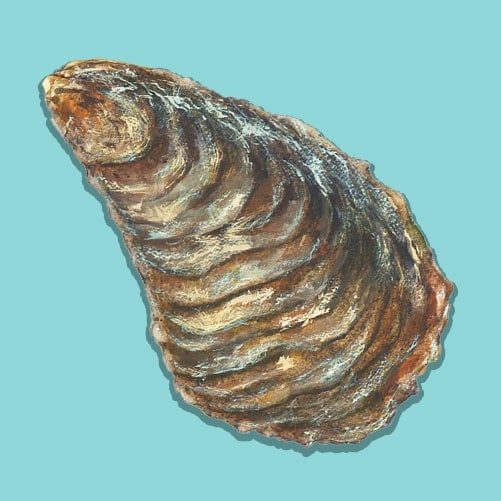
6. Atlantic Oysters
Atlantic oysters are found along the Atlantic coast of North America, from Canada down to the Gulf of Mexico. Otherwise known as “Eastern Oysters”, 85% of Atlantic oysters are harvested in the US alone, often earning it the name of “The American Oyster”. Atlantic oysters come in numerous varieties, including Bluepoints, Wellfleets, and Malpeques. Atlantic oysters are known for their briny flavor and firm texture. They are often enjoyed raw on the half-shell or used in a variety of cooked dishes.
- Eastern Oysters Taste: Salty and briny with a chewy meat
- Eastern Oysters Shell Design: Distinguishable paisley or pear outline
- Eastern Oysters Growing Region: America’s East Coast and Gulf of Mexico
Back to Top
Clam and Oyster FAQs
We answer some of the most common clam and oyster questions below:
When Are Clams in Season?
While clams are available all year round, it is recommended to only eat them during the “R” months (September-April) as shellfish can absorb toxins that are spread by “red tides”. Red tides come about in the summer months and are caused by algae, which produces toxins that make it dangerous to eat shellfish and kill fish entirely. When the algae blooms, it turns the water red, creates toxins in the water, and can even make the surrounding air harmful to breathe.
When Are Oysters in Season?
Oysters can be found on a restaurant's menu all year round, as most oysters are now farmed in temperature-monitored and toxin-free waters, rather than harvested in wild waters where algae can bloom.
Pacific vs Atlantic Oysters
In the US, there is a lot of debate from coast to coast on who has the best oysters. Pacific oysters are sweeter and plumper, with a round, deep-cut shell that has beautiful fluted edges. Atlantic oysters are more salty and briny with chewier meat. Their shells are generally narrower with a distinguishable paisley-shaped outline.
Printable Version
From the delicate and briny flavor of Littleneck clams to the rich and creamy texture of Kumamoto oysters, there is a clam or oyster to suit the flavor preferences of your customers. Whether you are looking to serve them raw on the half shell, incorporate them into soups and stews, or use them as a base for flavorful seafood dishes, clams and oysters are versatile ingredients that can elevate any menu.
Back to Top





